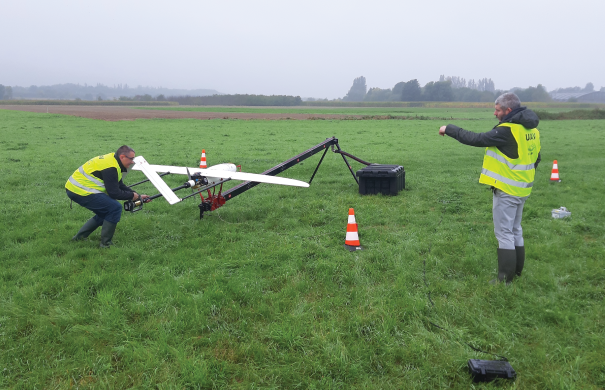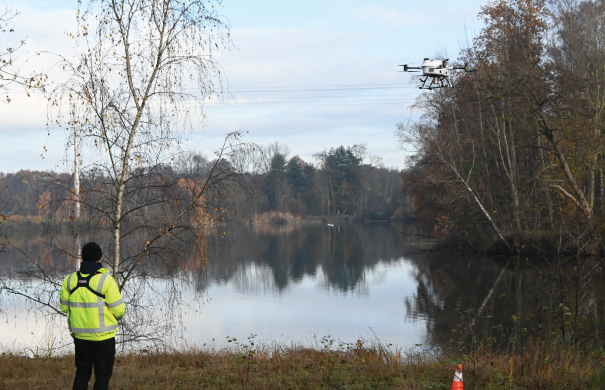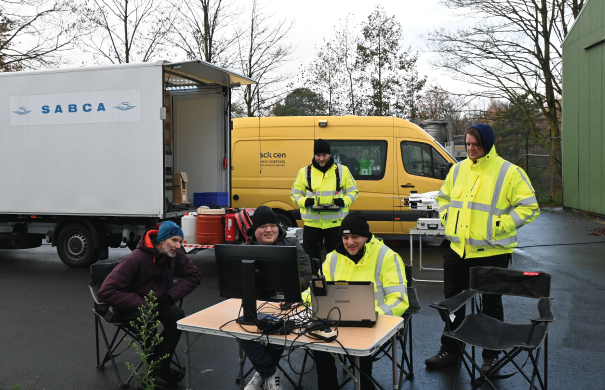The BUDDAWAK drone project
Overall results of the project
The Belgian Unmanned aerial systems for Decommissioning, Detection and AWAreness of radioactive risK or short BUDDAWAK project, funded by the Belgian Federal Public Service Economy, SMEs, Self-employed and Energy, under the Energy Transition Fund (ETF4 –project39) has come to an end. This provides us with the opportunity to present an overall overview of the results.
The project was defined as an industrial demonstration project, started in autumn 2020 and combined the unique expertise of SABCA in aeronautics and SCK CEN in the nuclear field to establish new opportunities and standards in radiological measurements with uncrewed aerial vehicles, commonly known as drones.
💡 Buddawak (Burri Bootyau) is the Aboriginal name for a mythical sooty owl, a nocturnal bird that nests in caves in Australia. It symbolizes the project, with SABCA providing the unique wings and rotors necessary to carry the large gamma-ray eyes (detectors) developed by SCK CEN.
2 drone-detector combinations
During the project two drone-detector combinations were designed, tested, and made operational: a fixed-wing long endurance system (with autonomy of up to 12 hours) carrying a single fully optimized CsI gamma-ray spectrometer and a large multicopter system equipped with a set of three large detectors, resulting in a high directional sensitivity to measure small amounts of radioactivity.
Separately from the development of the drone-detector systems, these systems underwent rigorous testing through a significant number of flights. The flights included, apart from test flights at DronePort, challenging flights above and around an industrial environment at the nuclear area Mol-Dessel. Surveys at higher altitude (200+ meters ground clearance) over nuclear installations have been performed as well as dedicated flights along buildings and waste storage locations. These flights demonstrated the utility of drone measurements for surveillance during normal activities or incidents, as well as in nuclear dismantling and decommissioning conditions.
Milestones achieved in the BUDDAWAK project
Fixed wing UAS with CsI detector system
🎞️ Be sure to watch this video to see the fixed-wing drone in action.
The first milestone was the coupling of an optimized payload consisting of a CsI detector system to a fixed wing UAS. The fixed wing UAV displaying a wingspan of 3.3 m, a maximum take-off weight of 23 kg and the ability to reach maximum speed up to 94 km/h. It can operate at altitudes of up to 15000 feet, powered by its two stroke petrol engine. The UAV is launched by a catapult and features a parachute and airbag for recovery. It offers an impressive endurance of 12 h and a range of 100 kilometer. The setup is ideal for surveillance flights over large areas and/or flights over extended periods of time. The detector system was fully customized (in term of type, size, and electronics) to achieve maximum sensitivity for the detection of radiation from radionuclides such as Cs137 and Co60, while adhering to the imposed payload restrictions of 2.5 kilogram. Based on extensive Monte Carlo simulations, the system was designed, made operational, tested and calibrated. Subsequently, the detector system was fully integrated into the fixed-wing UAV. The coupling of the detector systems with the drone, as well as the initial data collection with the integrated system in the UAS was performed by Annelies Verlinden, the Federal Minister of Interior Affairs during a working visit at SCK CEN on May 18th, 2021.
After a series of comprehensive ground tests, it was determined that there were no interferences between the fixed-wing drone and the detector system that could compromise the flight safety. Subsequently, flight plans, including an emergency response plan (ERP), Specific Operations Risk Assessments (SORAs) & CONcept of OPerationS (CONOPS), have been drafted and authorizations were requested for flights within a relevant industrial setting. In the meantime, test-flights were executed at DronePort, in Sint Truiden. Throughout these flights, various flight patterns, including circular and grid-based patterns, were tested and a methodology for converting the raw measurement data into meaningful parameters, such as soil radionuclide concentrations, along with corrections for ground clearance, was established and verified. An open access scientific paper on this was published in Remote sensing.

Once the Belgian civil aviation authorities granted permission for flights above the nuclear installations in the Mol-Dessel area, 4 full days of flights were executed, resulting in the collection of over 47 000 individual gamma-ray spectra. The results showed that the sensitivity and flexibility of the system, even when operated more than 200 meters above the ground, and with radiation levels within regulatory standards, allowed for a comprehensive assessment of the radiological situation. The high temporal and spatial resolution enabled the detection and identification of both static radiation levels from waste storage at different locations as well as changing radiation levels due to minor atmospheric releases of radioactivity during normal operation of the Belgian Reactor 1 (BR1).
In conclusion, the fixed-wing system clearly exceeded the anticipated outcome originally set when commencing the project. If planned in advance, the system can be deployed within 2 hours to conduct radiation level assessments in an area. Its capability is applicable not only in the context of emergency response but also during routine radiological surveillance of sites or suspicious locations (e.g. such as in the context of security events). This corresponds to a technology readiness level (TRL) near 8 or 9, rather than the initial anticipated TRL 5.
Multi-copter system with unique radiation payload
Parallel to the fixed-wing platform for radiological measurements, a multi-copter system was developed with a unique radiation payload. The multi-copter allows for hovering and detailed screening of smaller environments, which is crucial during nuclear dismantling and decommissioning. As part of the project, a specialized multi-copter tailored for nuclear applications was developed. This involved the development of a hexacopter with tilted arms for enhanced stability, removable arms with a span exceeding 2 m, a 45 minute endurance with 5 kg payload capacity, basic collision avoidance using integrated LIDAR technology, an Ethernet bus system and an LTE module (Long Term Evolution cellular technology) for communication with the payload. Additionally, the multi-copter featured an IP55 protection, safeguarding it against low-pressure water jets from all directions. The radiation detection system, was again fully customized, employing an innovative design approach to confer directional sensitivity to the detection system without necessitating heavy shielding. This not only prevented an increase in payload weight, but also enhanced detection efficiency. The design study resulted in an innovative system consisting of three cylindrical CsI scintillation detectors, each measuring 7 cm (diameter) x 7 cm (length), equipped with Si-photomultipliers. When the readings from the three detectors are summed, it results in exceptionally high detection efficiency, even at high gamma-ray energy levels. However, when the measurements of the individual detectors are analyzed separately, it gives directional sensitivity, allowing for higher spatial resolution during in-flight measurements. Due to component delivery issues for the hexacopter UAS, tests and flights carrying the payload were conducted with a fully electric Octocopter (X8 configuration), featuring a maximum take-off weight (MTOW) of 22 kg, a maximum speed of 72 km/h, a 7 m/s climb rate at MTOW, 6 kg payload capability with 15 minutes endurance and equipped with an integrated parachute.

After intensive ground testing, preliminary flights were executed at DronePort and SCK CEN, using first well-defined point sources. This enabled the system to be evaluated under well characterized reference conditions, encompassing flights at varying altitudes, speeds and patterns and for different source geometries. One of the challenges encountered was the calibration of the detection system’s directional sensitivity. This was particularly challenging due to the critical importance of accurately determining the absolute orientation of the detection system, especially when mounted on a moving UAV. To optimize the detection sensitivity, an experimental set-up was constructed off-line. Within this setup radiation sources, consisting of low-activity sources below the exemption level, could orbit around the detector system at different distances. The culmination of these tests and calibration efforts resulted in an operational system, accompanied by a real-time software package for interpreting the measurements.
Subsequently, the system was showcased and demonstrated in a relevant environment. During different flight days, a total of 3 x 11 000 individual gamma-ray spectra were collected while flying along waste containers, BR3 buildings and other complex structures. The system allowed swift detection of elevated radiation levels, identification of specific radionuclides involved and indicated the direction from which the majority of the radiation originated. A scientific paper related to these measurements is currently in preparation.
Dissemination workshop
Finally a technical dissemination workshop was organized at Tabloo in Dessel on May 30th, 2023 for all interested stakeholders, including authorities, the nuclear industry, research institutes and NGOs. During this workshop, the goals and results of the projects were presented and discussed. During a panel discussion regarding the future applications of this type of UAV-technology, the advantages of the system were emphasized for use in both routine and emergency scenarios, as well as for the processes associated with dismantling and decommissioning.

Future plans
Beyond the results achieved in the BUDDAWAK project, the expertise gained during the project has fostered a strong sense of confidence within SABCA and SCK CEN. They are confident that, by using the systems developed during the project or leveraging the expertise gained to create customized solutions, they can effectively address any inquiries regarding radiological monitoring in the outdoor environment using Uncrewed Aerial Systems. Furthermore, they can conduct these missions safely even in complex and challenging environments.